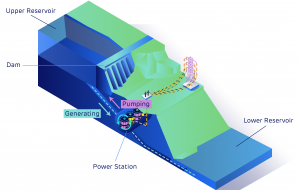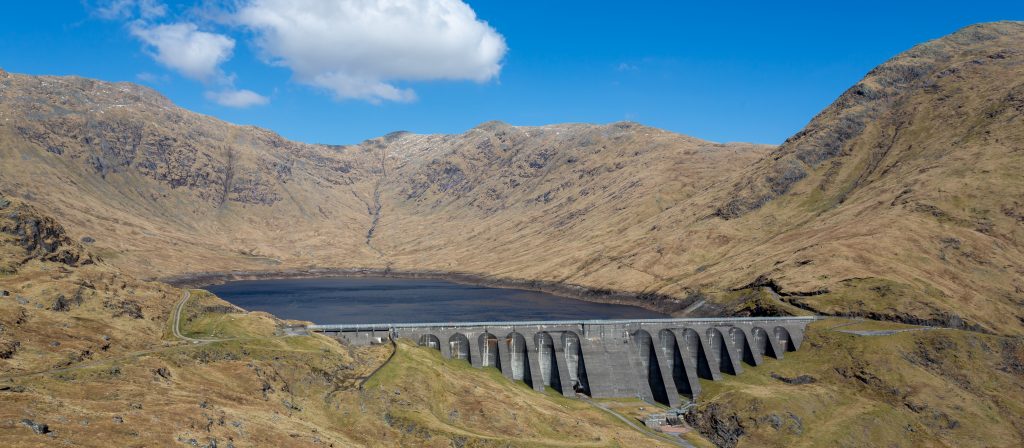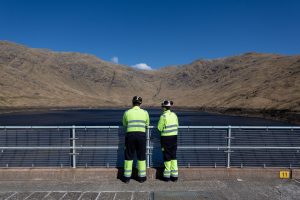
What is pumped storage hydro?
Pumped storage hydro (PSH) is a large-scale method of storing energy that can be converted into hydroelectric power. The long-duration storage technology has been used for more than half a century to balance demand on Great Britain’s electricity grid and accounts for more than 99% of bulk energy storage capacity worldwide.
Hydropower can also be very effective at a smaller, more local level, using relatively small rivers. These smaller hydro facilities can bring renewable electricity to remote areas and serve local needs. All they need is an abundance of flowing water to spin their turbines.
Bought by Drax in December 2018, Cruachan Power Station is one of only four pumped storage hydro stations in the UK and has enough capacity to power 1.4 million homes.
How does pumped storage hydro work?
The principle is simple. Pumped storage facilities have two water reservoirs at different elevations on a steep slope. When there is excess power on the grid and demand for electricity is low, the power is used to pump water from the lower to the upper reservoir using reversible turbines. When demand is high, the water is released downhill into the lower reservoir, driving the turbines the other direction to generate electricity.
Pumped storage hydro plants can also provide ancillary services to help balance the power system, such as inertia from spinning turbines, which ensures the system runs at the right frequency and reduces the risk of power cuts.
How do river-powered hydro schemes work?
River-powered hydro schemes, also known as run-of-river hydro schemes, work by using the natural flow of a river to generate electricity without the need for large reservoirs. They can operate in different ways, such as:
- Diverting water: A portion of the river’s flow is diverted through a channel or penstock, directing the water towards the hydroelectric power station.
- Turbines: The diverted water flows through turbines, which are large machines with blades. The force of the water causes the turbines to spin.
- Electricity generation: As the turbines spin, they are connected to generators. The mechanical energy from the spinning turbines is converted into electrical energy through electromagnetic induction.
- Transmission: The generated electricity is then transmitted through power lines to homes, businesses, and industries for use.
One of the key advantages of run-of-river hydro schemes is that they have a lower environmental impact compared to conventional hydro schemes with large reservoirs. However, their power output may vary depending on the river’s flow, which can be affected by seasonal changes and weather conditions.
Drax Group acquired the Lanark and Galloway run-of-river hydro schemes, located in south-west Scotland in 2018. The schemes have a combined capacity of 126 MW – enough to provide electricity to 400,000 homes.
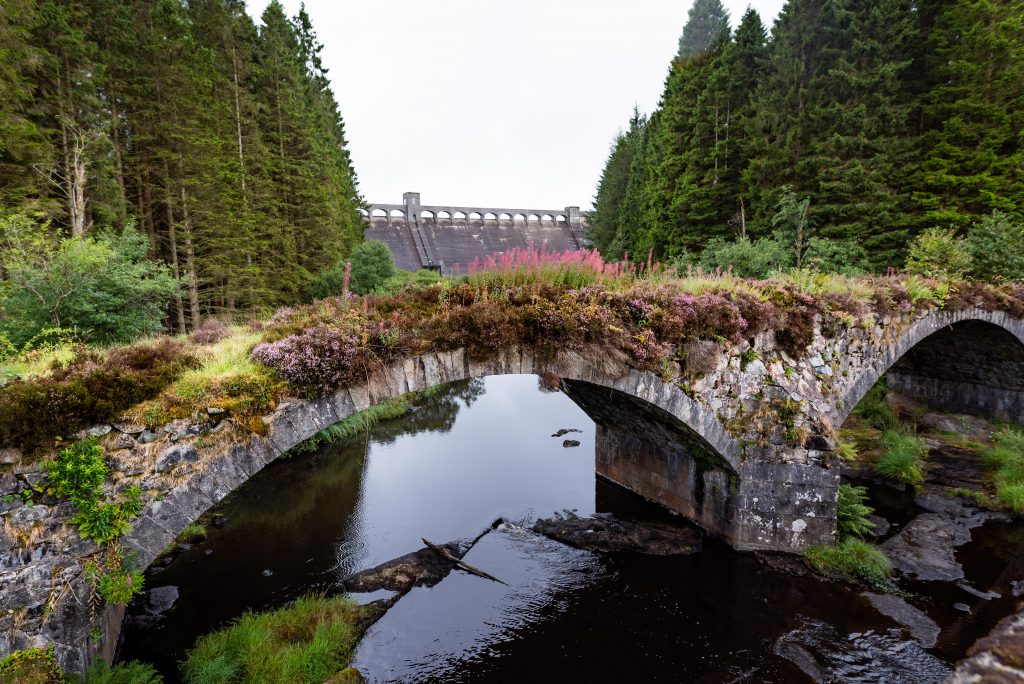
Clatteringshaws Dam, Galloway Hydro Scheme
Why is pumped storage hydro important for decarbonisation?
Governments around the world are shifting from fossil fuels to renewable energy sources to meet their climate goals. But critically important power technologies such as wind and solar pose challenges for power grid operators.
Being weather-dependent, the supply from these renewables is intermittent. For example, wind farms accounted for almost a quarter of the UK’s total electricity generation in 2020, but on some days, less than 10% of the country’s electricity needs were met by wind.
When output from renewables falls, grid operators mostly turn to gas-fired power stations to plug the gap. But relying on fossil fuels such as natural gas in the long term to balance the grid will compromise efforts to reach net zero emissions by 2050.
Pumped storage hydro facilities act as vast ‘water batteries’. They are a flexible way of storing excess energy generated by renewables, cost-effectively and at scale.
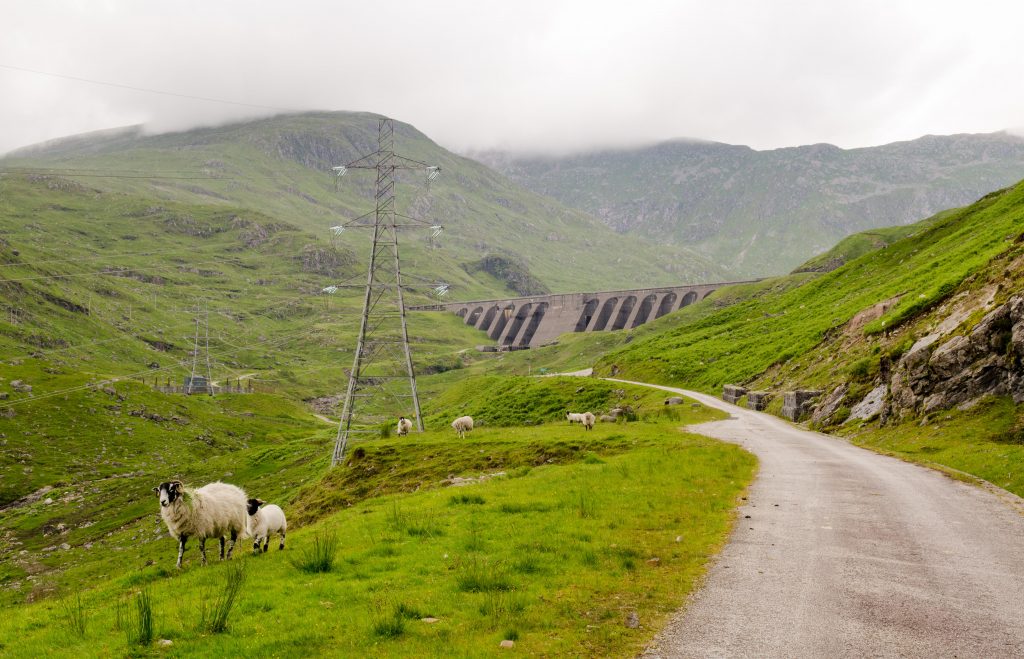
The impact of pumped storage hydro in the UK
At Drax, we have plans to expand Cruachan Power Station, more than doubling the electricity generating capacity at Cruachan. On 21st July 2023 Scottish Ministers granted consent for the Cruachan Expansion Project. The decision from the Scottish Government allows Drax to progress their ground-breaking plans to build a new c.£500m underground pumped storage hydro plant.
A report by Scottish Renewables and BiGGAR Economics has found that six projects currently under development in Scotland, including Cruachan 2 will:
- More than double the UK’s pumped storage hydro capacity to 7.7GW.
- Create almost 15,000 jobs.
- Generate up to £5.8 billion for the UK economy by 2035.
FAQs
- Why does the UK need to invest in new pumped storage hydro projects?
- How can pumped storage hydro capacity be increased?
- What policies are needed to support pumped storage hydro?
- How do power stations such as Cruachan help to protect the natural environment?
Growing the UK’s pumped storage hydro capacity is crucial to integrating more wind and solar power onto the energy grid, enhancing the nation’s energy security while tackling climate change.
Six projects currently under development in Scotland, including Cruachan 2, will more than double the UK’s pumped storage hydro capacity to 7.7GW, create almost 15,000 jobs and generate up to £5.8 billion for the UK economy by 2035, a report by Scottish Renewables and BiGGAR Economics has found.
‘The Economic Impact of Pumped Storage Hydro’ studied the economic impact of six pumped storage hydro projects currently in development in Scotland. These projects, if constructed, would add 4.9GW to the UK’s existing capacity of 2.8GW to go over halfway towards achieving the 15GW of capacity that is expected to be needed by 2050.
As old thermal power plants are decommissioned and renewables provide an increasing share of the electricity supply, storage capacity will need to grow if climate goals are to be met. Over the next two to three decades, Great Britain’s energy storage capacity alone will need to increase tenfold, from 3 gigawatts (GW) to around 30 GW.
Pumped storage hydro power stations require very specific sites, with substantial bodies of water between different elevations. There are hundreds, if not thousands, of potential sites around the UK, including disused mines, quarries and underground caverns, but the cost of developing entirely new facilities is huge. A more cost-effective way to increase storage capacity is by expanding existing plants, such as the Cruachan Power Station in Scotland.
Long-duration energy storage is essential for a renewable future, but government must act to unlock investment.
The expansion of projects such as the Cruachan expansion requires an updated financial stabilisation mechanism from the UK Government. The current absence of a framework for large-scale, long-duration storage technologies has resulted in no new plants being constructed in the UK since 1984, despite their critical role in the decarbonisation process.
The Association for Renewable Energy and Clean Technology (REA) advised that a new market mechanism is needed before projects such as Cruachan 2 can be deployed.
New financial mechanisms, such as a cap and floor regime, are needed to enable investors to back capital-intensive, long-term projects that will save consumers and the grid millions.
Getting Britain ready for the next generation of energy projects
The Highland landscape that surrounds Cruachan Power Station is integral to how it runs and preserving these landscapes and the life that thrives in them is crucial to both the environment and economy of the region.
For the past seven years, an ecologist has conducted surveys of the site in support of the Biodiversity Action Plan, which covers the area from the Visitor Centre to the dam. The area has operated a Biodiversity Plan since 2005, to help wildlife on its landholdings. It promotes habitats and species, and sets out a timetable for improvement measures.
View Cruachan Power Station’s Biodiversity Survey 2022 here.
Cruachan Power Station: Protecting biodiversity while generating power
Growing the UK’s pumped storage hydro capacity is crucial to integrating more wind and solar power onto the energy grid, enhancing the nation’s energy security while tackling climate change.
Six projects currently under development in Scotland, including Cruachan 2, will more than double the UK’s pumped storage hydro capacity to 7.7GW, create almost 15,000 jobs and generate up to £5.8 billion for the UK economy by 2035, a report by Scottish Renewables and BiGGAR Economics has found.
‘The Economic Impact of Pumped Storage Hydro’ studied the economic impact of six pumped storage hydro projects currently in development in Scotland. These projects, if constructed, would add 4.9GW to the UK’s existing capacity of 2.8GW to go over halfway towards achieving the 15GW of capacity that is expected to be needed by 2050.
Find out more about the Cruachan Expansion Project
View MoreAs old thermal power plants are decommissioned and renewables provide an increasing share of the electricity supply, storage capacity will need to grow if climate goals are to be met. Over the next two to three decades, Great Britain’s energy storage capacity alone will need to increase tenfold, from 3 gigawatts (GW) to around 30 GW.
Pumped storage hydro power stations require very specific sites, with substantial bodies of water between different elevations. There are hundreds, if not thousands, of potential sites around the UK, including disused mines, quarries and underground caverns, but the cost of developing entirely new facilities is huge. A more cost-effective way to increase storage capacity is by expanding existing plants, such as the Cruachan Power Station in Scotland.
View MoreLong-duration energy storage is essential for a renewable future, but government must act to unlock investment.
The expansion of projects such as the Cruachan expansion requires an updated financial stabilisation mechanism from the UK Government. The current absence of a framework for large-scale, long-duration storage technologies has resulted in no new plants being constructed in the UK since 1984, despite their critical role in the decarbonisation process.
The Association for Renewable Energy and Clean Technology (REA) advised that a new market mechanism is needed before projects such as Cruachan 2 can be deployed.
New financial mechanisms, such as a cap and floor regime, are needed to enable investors to back capital-intensive, long-term projects that will save consumers and the grid millions.
Getting Britain ready for the next generation of energy projects
View MoreThe Highland landscape that surrounds Cruachan Power Station is integral to how it runs and preserving these landscapes and the life that thrives in them is crucial to both the environment and economy of the region.
For the past seven years, an ecologist has conducted surveys of the site in support of the Biodiversity Action Plan, which covers the area from the Visitor Centre to the dam. The area has operated a Biodiversity Plan since 2005, to help wildlife on its landholdings. It promotes habitats and species, and sets out a timetable for improvement measures.
View Cruachan Power Station’s Biodiversity Survey 2022 here.
Cruachan Power Station: Protecting biodiversity while generating power
View More







